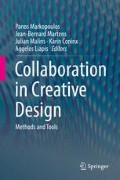Abstract
Practitioners from different fields of design and research apply the ‘Probing’ method as means of getting a better understanding of their users and to inspire their designs. During the 15 years since its first appearance, the probing method has been extended for deployment in different contexts and for different uses. In this chapter we first briefly introduce what probes are about, then we look at probing from two perspectives: (a) as a process of collaborative discovery and learning, and (b) as a tool for entering the users’ contexts. We illustrate these perspectives through cases in which probes have been introduced in educational and professional environments. Based on the findings, we discuss how a making process of probes can engage a design research team to the issues of concern, and present a set of problems and challenges encountered while probing professional work. Finally, we propose a set of considerations for designing probes for different purposes.
Access this chapter
Tax calculation will be finalised at checkout
Purchases are for personal use only
Key References for Further Reading
Boehner K, Vertesi J, Sengers P, Dourish P (2007) How HCI interprets the probes. In Proc. of CHI’07, ACM Press, 1077–1086.
Gaver W, Dunne T, Pacenti E (1999) Cultural probes. Interactions 6(1), January, ACM, 21–29.
Gaver W, Boucher A, Pennington S, Walker B (2004) Cultural probes and the value of uncertainty. Interactions 11(5), September, ACM, 53–56.
Lucero A, Lashina T, Diederiks E, Mattelmäki T (2007) How probes inform and influence the design process. In Proc. DPPI '07, ACM Press, 377–391.
Mattelmäki T (2006) Design probes. Dissertation. University of Art and Design Helsinki, Finland.
Wallace J, McCarthy J, Wright PC, Olivier P (2013) Making design probes work. In Proc. of CHI’13, ACM Press, 3441–3450.
References
Boehner K, Vertesi J, Sengers P, Dourish P (2007) How HCI interprets the probes. In: Proceedings of CHI ’07, ACM Press, 1077–1086
Brandt E (2006) Designing exploratory design games: a framework for participation in Participatory Design? In: Proceedings of PDC ’06, ACM Press, 57–66
Carter S, Mankoff J (2005) When participants do the capturing: the role of media in diary studies. In: Proceedings of CHI ’05, ACM Press, 899–908
Ellis C (2004) The ethnographic I: a methodological novel about auto ethnography. AltaMira Press, Walnut Creek
Fogg BJ (2003) Persuasive technology: using computers to change what we think and do. Morgan Kaufmann, Boston
Gaver W, Dunne T, Pacenti E (1999) Cultural probes. Interactions 6(1):21–29, ACM
Gaver W, Boucher A, Pennington S, Walker B (2004) Cultural probes and the value of uncertainty. Interactions 11(5):53–56, ACM
Hemmings T, Crabtree A, Rodden T, Clark K, Rouncefiled M (2002) Probing the probes. In: Proceedings of PDC ’02, pp 42–50
Hulkko S, Mattelmäki T, Virtanen K, Keinonen T (2004) Mobile probes. In: Proceedings of NordiCHI ’04, ACM Press, pp 43–51
Hutchinson H, Mackay W, Westerlund B, Bederson BB, Druin A, Plaisant C, Beau-douin-Lafon M, Conversy S, Evans H, Hansen H, Roussel N, Eiderbäck B (2003) Technology probes: inspiring design for and with families. In: Proceedings of CHI ’03, ACM Press, pp 17–24
Jääskö V, Mattelmäki T (2003) Methods for empathic design: observing and probing. In: Proceedings of DPPI ’03, ACM Press, pp 126–131
Lee J (2014) The true benefits of designing design methods. Artifacts 3(2):1–12
Lucero A (2009) Co-designing interactive spaces for and with designers: supporting mood-board making. Doctoral dissertation, Eindhoven University of Technology, The Netherlands
Lucero A, Martens J-B (2006) Supporting the creation of mood boards: industrial design in mixed reality. In: Proceedings of TableTop 2006, IEEE
Lucero A, Mattelmäki T (2007) Professional probes: a pleasurable little extra for the participant’s work. In: Proceedings of IASTED-HCI 2007, ACTA Press, pp 170–176
Lucero A, Lashina T, Diederiks EMA (2004) From imagination to experience: the role of feasibility studies in gathering requirements for ambient intelligent products. In: Proceedings of EUSAI 2004. Springer, Berlin/Heidelberg, pp 92–99
Lucero A, Lashina T, Diederiks E, Mattelmäki T (2007) How probes inform and influence the design process. In: Proceedings DPPI ’07, ACM Press, pp 377–391
Mattelmäki T (2003) Probes – studying experiences for design empathy. Empathic design – user experience in product design. IT Press, Helsinki, 119–130
Mattelmäki T (2005) Applying probes – from inspirational notes to collaborative insights. CoDesign 1(2):83–102, Taylor & Francis, London
Mattelmäki T (2006) Design probes. Dissertation, University of Art and Design Helsinki, Finland
Mattelmäki T (2008) Probing for co-exploring. CoDesign 4(1):65–78
Mattelmäki T, Battarbee K (2002) Empathy probes. In: Proceedings of PDC 2002, CPSR, pp266–271
Papert S (1980) Mindstorms – children, computers and powerful ideas. Basic Books, New York
Paulos E, Jenkins T (2005) Urban probes: encountering our emerging urban atmospheres. In: Proceedings of CHI ’05, ACM Press, pp 341–350
Sanders EB (2001) Virtuosos of the experience domain. In: Proceedings of the 2001 IDSA education conference
Wallace J, McCarthy J, Wright PC, Olivier P (2013) Making design probes work. In: Proceedings of CHI’13, ACM Press, pp 3441–3450
Author information
Authors and Affiliations
Corresponding author
Editor information
Editors and Affiliations
Rights and permissions
Copyright information
© 2016 Springer International Publishing Switzerland
About this chapter
Cite this chapter
Mattelmäki, T., Lucero, A., Lee, JJ. (2016). Probing – Two Perspectives to Participation. In: Markopoulos, P., Martens, JB., Malins, J., Coninx, K., Liapis, A. (eds) Collaboration in Creative Design. Springer, Cham. https://doi.org/10.1007/978-3-319-29155-0_3
Download citation
DOI: https://doi.org/10.1007/978-3-319-29155-0_3
Published:
Publisher Name: Springer, Cham
Print ISBN: 978-3-319-29153-6
Online ISBN: 978-3-319-29155-0
eBook Packages: Computer ScienceComputer Science (R0)

